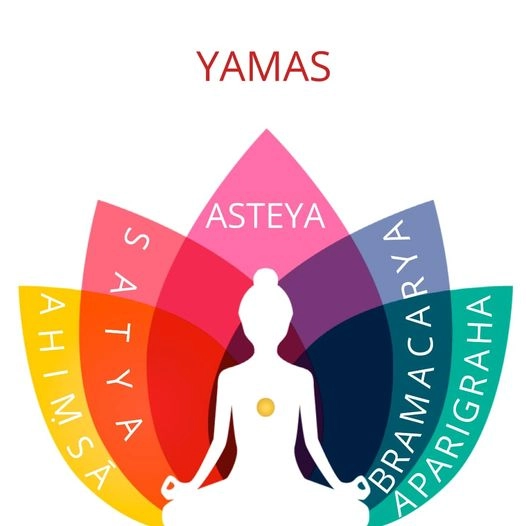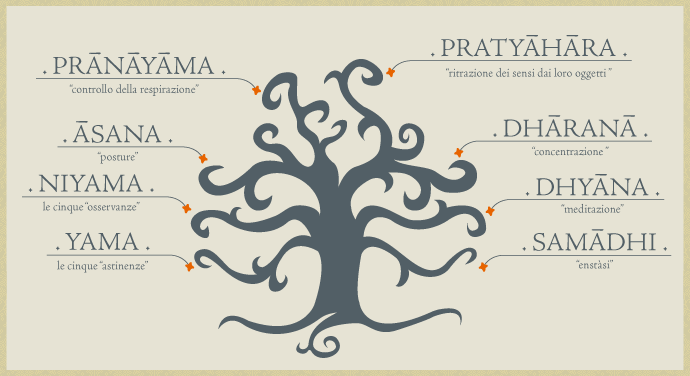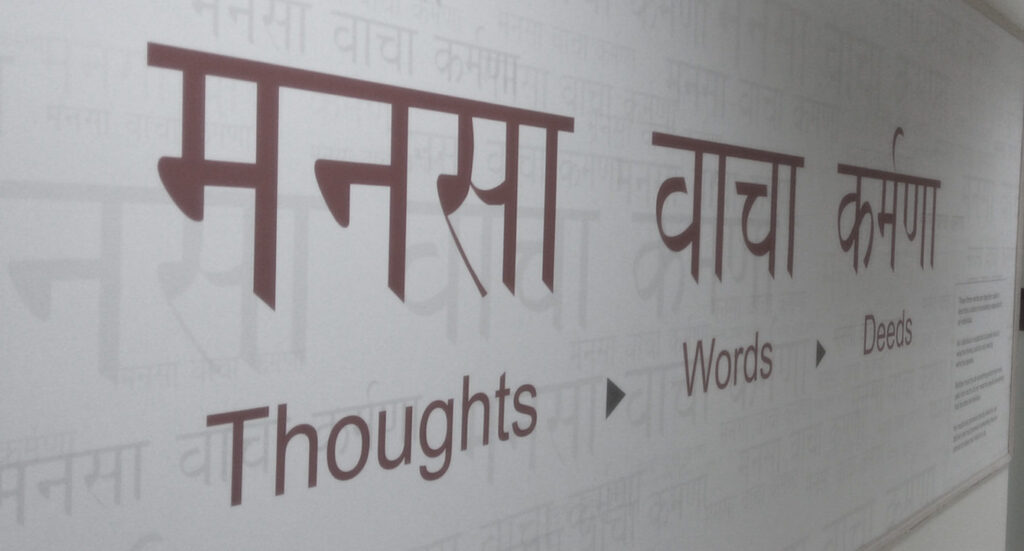
According to the ancient text, ‘The Yoga Sutras of Patanjali’, Maharishi Patanjali has given the 8 sutras or guidelines for life’s journey for ethical living. In our previous post, we learnt what the eight limbs(sutras)are( also known as Ashtang Yoga). Now we will learn in detail about the first limb, namely, the Yamas. As a prelude to asanas, pranayama, and meditation, a spiritual student is first guided to master the yamas.
By observing the Yamas we can remove the blocks that are hindering our journey and create sacred space.
What are Yamas?
Yam is the first limb of the eightfold Yogic path for spiritual practice, as outlined in the Yoga Sutras. Yama is a Sanskrit word, which means ‘ restraints’ when translated into English. The yamas are the restraints which are to be (socially) observed when you are on a yogic path. These are primarily guidelines for ethical social conduct.


There are 5 yamas.
- Ahimsa: Non-violence
- Satya: Truthfulness
- Asteya: Non-stealing
- Brahmacharya: Non-excess
- Aparigraha: Non-possessiveness/ non-hoarding
What is the way to follow the yamas?
The yamas are to be followed totally and completely in three ways
Mansa – (in Thoughts)
Vacha – (in Words),
Karmana – (in Actions)

It means that we follow all the five yama practices internally as well as externally.
Ahimsa: Non-violence अहिंसा
Non-violence is the starting point of a sadhak’s spiritual journey from gross to subtle. Being a vegetarian in food habits and compassionate toward other living beings.
This whole world and everything in it is created by a Single Unseen Force and we are all part of that. How can we think of hurting anyone or anything which is a part of this mystical divine Force?
Thus, out of all the things that help us in our spiritual journey, ahimsa, or non-violence, is the first and most vital.
We are and become what we Think, Speak, and Eat. Being mindful of each aspect initiates the shift from the Gross to the Subtle.
The serious seeker, thus, starts the Journey in Ahimsa or Non-Violence, in thoughts, in spoken words and in his actions.
Thoughts: We hurt ourselves first and foremost when there is a negative thought inside us. Our each thought needs to be pure, sacred, non-hurting, and helping other beings.
Words: What we think, gets expressed as words, and words once spoken, cannot be taken back. Every spoken word needs to be a soft and sweet one.
Action: Being Vegetarian in food habits, being peaceful, kind, and gentle in nature should be the hallmark of our actions.
From moment to moment taking care of thoughts and words will automatically lead to the right actions and reactions inside and outside of us.
Our body is a TEMPLE. We are the Temple of Inner Wisdom. Being the divine abode of, we, the SOUL, it becomes imperative to treat this space with utmost Sacredness.
AHIMSA being the starting point !!
Satya: Truthfulness
Truthfulness in words, deeds, and intentions.
Our innermost Truth is Light. Operating in Truth brings out that light.
As we take a plunge into spirituality, we all want to know the Ultimate Truth, the hidden realities that exist around and within us. For this, we need to take a serious look at how Truthful we are with ourselves, as well as others.
A seeker should have truthfulness in :
Thoughts: The clarity and purity in your intention, is Truthfulness in thoughts.
Is your intention clear? Or is there something else behind it that you are hiding?
Words: Always speak with kindness and Ahimsa. Every word, being authentic and genuine.
Actions: Straightforwardness in your approach, is Satya.
Let there be integrity between your words and actions.
The innermost truth will get revealed to us, when we take care of each and every truth in our day-to-day life, however small it may be.
Asteya: Non-stealing अस्तेय- 1st Yama
Asteya means non-stealing or not claiming anything that doesn’t belong to oneself.
Accepting that :
~ Life is Complete and Abundant.
~ Every need is provided for by the Universe.
When we take birth, we bring nothing with us. When we leave the world, we take nothing back with us. So, can we really claim anything as ours?
Whatever is required by us during this journey, from our first to our last breath, is readily provided by the universe, at the exact time and in the most appropriate manner. Yet, we become desirous to acquire more and more from the outside world. This stems from a basic sense of lack and incompleteness within us. We have to let go the feeling of incompleteness.
Asteya is nonstealing or non-claiming anything that doesn’t belong to oneself, both at the physical and inner level. It hastens the progress of a true spiritual seeker.
Practising Asteya in ~
Thoughts: not intending or desiring to possess anything unethically.
Words: not holding back words of appreciation and encouragement.
Actions: not forcefully claiming something; not encroaching into other’s private time and space. And, not acquiring anything beyond our needs.

Accept that
1. Life is complete.
2. There is abundance.
3. The universe always provides and takes care of all our requirements.
This brings down our needs and starts making us feel content and complete within ourselves. Our life has to be about giving and not just taking. 🤗
Brahmacharya: Non-excess ब्रह्मचर्य
The literal meaning of Brahmacharya is being on the path to the Super Consciousness (Brahman) or the divine within.
Brahman is ‘the ultimate reality’, and Charya is ‘the path’ towards that realization.
Brahmacharya is the stage of life, till around 25 years, when a student, under the guidance of a realized Guru is focused on a lifestyle conducive to the realising of Brahman, the Ultimate Reality.
It included cleanliness, ahimsa, simple living, studies, meditation, restraint on food, intoxicants, and the practice of celibacy.
In this context, brahmacharya connotes chastity during the student stage of life for the purpose of attaining spiritual liberation.
It is a misnomer to think of Brahmacharya as Celibacy and Brahmachaari as a celibate.
Braahman is the one who has realized Brahman.
Brahmacharya is the path towards Brahman.
Brahmachari is the one on that path.
Whatever the stage of life, Grihastha, Vanaprastha, or Sannyasa; a passionate student is always a brahmachari or a brahmachaarini.
Brahmacharya in
Thoughts: Consciously withdrawing the mind from sensory cravings in a measured and disciplined manner leading to freedom from sensual dependencies.
Words: Giving one a chance to express one’s desires in a balanced and appropriate manner.
Action: Allowing the awake and active senses to moderate activity by self-restraint.
Brahmacharya presents us with positive strategies for curbing the inclination to overindulge in any of our senses uncontrollably like eating, sleeping, sex, etc.
Each one of us on the journey to realize the Brahman should strive to be a Brahmachaari or a Brahmachaarini.
Aparigraha: Non-possessiveness अपरिग्रह- Last yama
Aparigraha means non-possession or non-hoarding or not accumulating more than one’s needs.
Letting go of what is not serving us physically and emotionally. Moving from Limitedness to Unlimitedness.
A (अ) – non;
Pari (परि) – on all sides;
Graha (ग्रह) – to take or grab.
Aparigraha is non-possessiveness; non-greed and non-attachment, to all physical, emotional, and mental baggages, which we amass throughout our journey.
Our Insecurity about the future and our inability to trust the universe that it will provide what is needed, compels us to acquire and be possessive about things and people.
We cling to many things at the physical, mental and emotional levels. APARIGRAHA is letting go of :
- More than what we need
- Attachments and being Possessive of people or relationships.
- Painful and unpleasant incidents, events, or situations that may have affected us.
- Past traumas, resentments.
- Unfruitful belief systems, opinions, and judgments.
- Doing good with the expectation of a benefit or a reward.
- All that is not serving us anymore and shifting from Limitedness to Unlimitedness
What we learnt
People wonder why they are not getting the desired results with asanas or pranayama or meditation. It is because they are ignoring the first two limbs of yoga- Yama and Niyama.
When we wholeheartedly follow the first limb of ashtanga yoga-(the Yamas), it allows us to go deeper into the second stage of the eight-limbed path—the Niyamas. We will discuss them in detail in our next post!
The above explanations are inspired by words uttered by the renowned Spiritual Guru Master Minood 🙏in his discourses.
Leave a Reply
You must be logged in to post a comment.